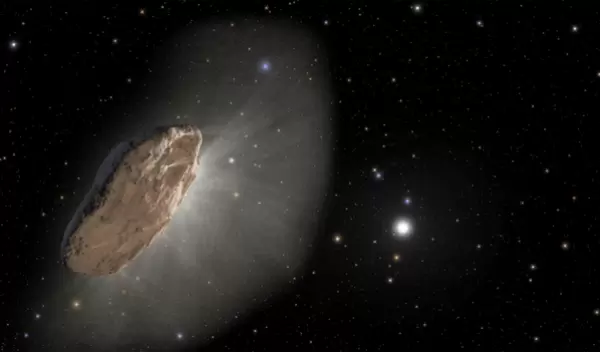
‘Alien’ comet 'Oumuamua's weird orbit may have surprisingly simple explanation
In 2017, a mysterious comet dubbed 'Oumuamua fired the imaginations of scientists and the public. It was the first known visitor from outside our solar system, it had no bright coma or dust tail like most comets, and had a peculiar shape — something between a cigar and a pancake. Its small size more befitted an asteroid than a comet.
But the fact that it was accelerating away from the sun in a way that could not be explained perplexed scientists, leading some to suggest that it was an alien spaceship.
Now, a University of California, Berkeley astrochemist and a Cornell University astronomer argue that the comet's mysterious deviations from a hyperbolic path around the sun can be explained by a simple physical mechanism likely common among many icy comets: outgassing of hydrogen as the comet is warmed up by sunlight.
The findings are supported in part by the U.S. National Science Foundation and are published in the journal Nature. "Astronomers would like to know if there are other examples of interlopers that sail through our solar system like 'Oumuamua," said Debra Fischer, director of NSF's Division of Astronomical Sciences. "When the Rubin Observatory is commissioned next year, we hope to find more of these fascinating objects."
What made 'Oumuamua different from every other well-studied comet in our solar system was its size. It was so small that its gravitational deflection around the sun was slightly altered by the tiny push created when hydrogen gas spurted out of the ice.
Most comets are essentially dirty snowballs that periodically approach the sun from the outer reaches of our solar system. When warmed by sunlight, a comet ejects water and other molecules, producing a bright halo or coma around it and often tails of gas and dust. The ejected gases act like thrusters on a spacecraft, giving the comet a tiny kick that alters its trajectory slightly from the elliptical orbits typical of other solar system objects, such as asteroids and planets.
When discovered, 'Oumuamua had no coma or tail and was too small and too far from the sun to capture enough energy to eject much water, which led astronomers to speculate wildly about its composition and what was pushing it outward. Was it a hydrogen iceberg outgassing hydrogen? A large, fluffy snowflake pushed by light pressure from the sun? A light sail created by an alien civilization? A spaceship under its own power?
Jennifer Bergner, a UC Berkeley chemist who studies the reactions that occur on icy rocks in the cold vacuum of space, thought there might be a simpler explanation. She broached the subject with a colleague, Darryl Seligman at Cornell University, and they decided to test it.
"A comet traveling through the interstellar medium basically is getting cooked by cosmic radiation, forming hydrogen as a result," Bergner said. "Our thought was: If this was happening, could you actually trap it in the body, so that when it entered the solar system and it was warmed up, it would outgas that hydrogen? Could that produce the force needed to explain the non-gravitational acceleration?"
She found that experimental research published from the 1970s through the 1990s demonstrated that when ice is hit by high-energy particles akin to cosmic rays, molecular hydrogen is abundantly produced and trapped in the ice. In fact, cosmic rays can penetrate tens of meters into ice, converting a quarter or more of the water to hydrogen gas.
"For a comet several kilometers across, the outgassing would be from a really thin shell relative to the bulk of the object, so both compositionally and in terms of any acceleration, you wouldn't necessarily expect that to be a detectable effect," Bergner said. "But because 'Oumuamua was so small, we think that it produced sufficient force to power this acceleration."
